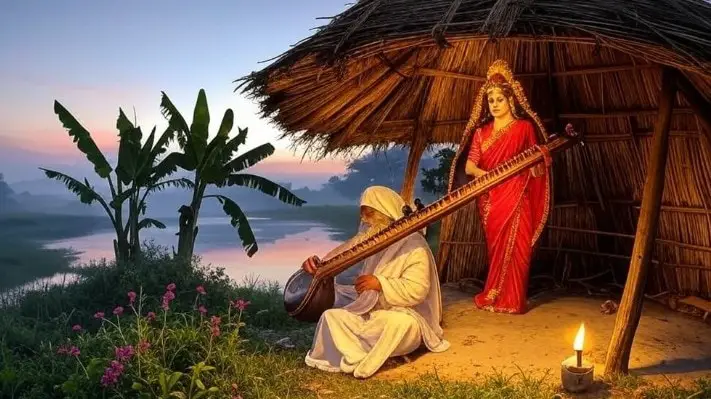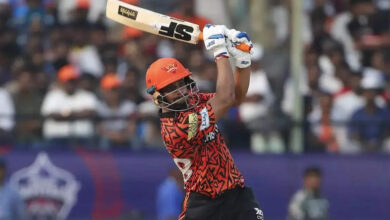Shakti Peetha’s protectors and a raga of music … What is the connection of this form of Goddess Durga? – Raag Bhairavi Devi Durga and Navratri Chaitra Navratri Puja Hindustani Classical Music NTCPVP

It is dawn time. Vihaan has not yet happened, but the horizon in the east direction is about to change the tone. The night has covered his zone and the tears flowing in his farewell have stopped as dew on the grass. The wind is blowing in the dim speed. The world is still sleepy, in laziness, in night disorder. All three are such demerits, who stop the path of consciousness in life. How will these demerits be removed?
This question just raises the head that before that the venue of Veena arises in a supreme holy hut and then the tone of Komal Rishabh, Komal Gandhar, Komal Dhaivat and Komal Nishad echoed. A serious tone is heard, in which Brahma is being called and it is being said, ‘Prabhu ji More Avagun Chit Na Dharo’
This is the voice of Baba Haridas. Baba used to perform regular music at dawn in the holy hut from the coast of Yamuna, Vanshivat’s shade and Tulsi, Harsingar and Banana plants. His hymn being sung in Raga Bhairavi is a sign of the arrival of the morning, the declaration of the passing of the night and the preparation of a new day for nature.
Raga Bhairavi in classical music
In Indian classical music, raga Bhairavi is included with all these characteristics. Such a raga which is full of soft warmth like the first ray of morning, is witness to deep feelings even after being adorned with soft notes. This raga is not only a group of vowels, but a spiritual journey, which takes the soul to the infinite depths of peace and love. On hearing the name of the raga Bhairavi, a sweet sanad starts echoing in the mind, as the bells of an ancient temple are slowly ringing from the dim air.
Goddess Bhairavi is a form of Goddess Durga
It is the time of Navratri and Goddess Puja continues. There are 9 forms of Goddess Durga, but many other forms and names of Goddess have also been mentioned in mythology. In this, the name of a power of Goddess Durga is Bhairavi. It is believed that like Mahadev Shiva’s Anshvatar Bhairav protects every Shaktipeeth, Goddess Bhairavi helps Bhairav as Rakshaika Devi of the same Shakti Peethas.
Equality between raga Bhairavi and Devi Bhairavi
However, the existence of Goddess Bhairavi is not limited to Purana stories only. In the tradition of classical music, Raga Bhairavi’s name is on the mother’s mother. Although Goddess Bhairavi is a fierce and universe goddess, the nature of raga Bhairavi is very serious, but even in this seriousness, a fickleness is involved in it. Therefore, love and adornment are also seen in raga Bhairavi as well as love and energy. It is said that Akbar’s court singer was a great devotee of Tansen’s Guru Shri Krishna and he did not do any special worship in Krishna devotion, but only raga Vandana.
He used to sing the positions of Krishna devotion in a raga and this was his worship. His singing was so amazing that raga-raginis used to appear in his hut in a spontaneous form and danced with his singing. He proved Goddess Bhairavi himself by singing raga Bhairavi.
Bhairav’s power is Bhairavi, the raga originated in the name of Goddess
Raga Bhairavi’s naming is based on a mythical goddess. The fiery power of Mahadev Shiva, which is called Bhairav, is the calm and female form of the same Bhairav. When the fiery Bhairav, with the inspiration of Sadashiva, makes the apocalypse, then Bhairavi starts a new beginning of creation with his soft notes. The meaning of the word Bhairavi is also “to defeat fear” and it is also a raga. Fear, anxiety and unrest goes away from the mind of the listener and he gets supernatural peace.
In mythology, mother Bhairavi has also been considered the goddess of power-harmony and creation, but in music, this raga emerges as a symbol of tenderness and compassion. That is why the singing of this raga is from the time of dawn, when nature is moving towards renaissance.
Raga Bhairavi is considered to be the basis of Bhairavi Theat in the Thaat system of Indian music. This Thaat contains all the vowels of the entire octave in itself, in which soft vowels are used prominently. This quality of raga Bhairavi separates it from other ragas, because here both freedom and emotional depth of vowels are present.
Such is the structure of raga bhairavi
Raga Bhairavi is the raga of an entire caste, the entire caste means that the seven notes of music are used, taking the raga, which is used to take the seven notes of the whole caste.
The seven notes are used in raga Bhairavi. Consciousness (sa), Rishabh (Ray), Gandhar (C), Medium (M), Pancham (P), Dhaivat (D) and Nishad (N). But its specialty is that it uses all soft vowels (ra, c, d, ni), which gives it a compassion and soulful color. The tone which is soft, it is (-) below it. Its ascension and descent are as follows,
Aroh: Sa, re (gentle), gp (gentle), ma, p, dha (gentle), ni (gentle), San
Avaroh: San, Ni (Komal), Dha (Komal), P, Ma, Ga (Komal), Re (Komal), Sa
The plaintiff of this raga is medium (ma) and condensed vowel conspiracy (sa). The medium tone is the soul of this raga, which gives it a deep emotional power. The use of soft vowels in raga Bhairavi fills it with a sweet and compassionate juice, which touches the heart of the hearer.
The time of singing of a raga, the meaning of that raga is most effective at that particular time. In ancient times, music was not just a means of entertainment but also the practice and medium of accomplishment. In these ragas, the verses of the Vedas were also sung and at what time the Richa can be proved, they needed to sing at their right time. In such a situation, in view of the specialty of atmosphere and nature on the basis of time, ragas were born on time for singing.
The singing of Bhairavi raga in the morning means that it was used for the siddhis of the morning. This is also considered special for Shiva worship, in such a situation, Bhairavi includes the hymns of Shiva devotion and more prayers for the gods. However, this raga can be sung at any time. Because its emotional appeal is beyond the limits of time.
Effect of raga bhairavi
The greatest quality of raga Bhairavi is its emotional effect. This raga is a confluence of devotion, love and peace. When its voices fall in the ears, it seems as if the whole world has stopped and only a sweet nation is left. This raga is considered a symbol of devotional juice, and so it is used in many hymns and thums. Apart from this, it also contains a shadow of compassionate juice and makeup juice, which makes it versatile.
When an artist starts Raga Bhairavi with an Alap, he slowly opens the vowels one by one, like feeding the morning sunny petals. First the stability of the conspiracy, then the compassion of the soft Rishabh, the sweetness of the soft Gandhar, and the depth of the medium gives rise to a new feeling. This raga takes the listener on a journey where the mind is calm and the soul becomes cheerful.
The use of raga Bhairavi is seen in classical music as well as folk music, bhajan, thumri, and even in film music. Its flexibility and emotional depth make it dear to all kinds of musicians. For example, great artists like Pandit Ravi Shankar, Ustad Bismillah Khan, and Pandit Bhimsen Joshi immortalized this raga in their presentations. Raga Bhairavi has a special place in Thumri singing, where it is sung in styles like “Kajri” and “Dadra”.
Baba Haridas used to sing Surdas’s restrictions
The special thing is that due to the raga of Vela, just before Prabhat, the restrictions of bhajan have been more composed in this raga. See a post composed by devotee poet Surdas. This is the same position which was written by Surdas, which was one of the poets of Ashtachhap. Both the great Krishna devotee Surdas and Krishna’s devotee Swami Haridas were contemporary, so many posts of Surdas were used by Swami Haridas.
Prabhu Ji More Determined Chit Na Dharu
Samadarsi is the name Tiharo
If you want to cross
Rakhat in a iron puja, a house
Paras virtues are not detected
Prabhu ji More ….
A rivers, a narrow saying, melley is Neer Bharo
When Dau Mili, one Baran Bharana, Sursari name
Prabhuji More …
A creature is a Brahma saying, Sur Shyam Jhagro,
This time beyond the berry, no one
However, it would be an insult to his Krishna devotion. In fact, Swami Haridas used to do his music practice only for God Bhajan. He was not a singer of court or audience. Whenever there was a sleeping sleeping in his heart, he used to sing and sang that the water of Yamuna collided with the dull wind, trees and coasts. It is said that there was a sweetness in his singing that deer used to come out of the dense forest and come to his hut. Baba Haridas was also the guru of famous musician Tansen and Baiju was also given music education to the great musician Baiju Bawra.
Raga Bhairavi in films
The use of raga Bhairavi in film music appears very beautifully. Especially when films were made in the 1940-50s, their songs were either inspired by folk music, or classical music. In this era, musicians have given classical music very neatly in cinema. Musicians like Naushad, C. Ramchandra, Anil Biswas have made it popular by including Raga Bhairavi in their songs. Even in later decades, this raga remained the choice of musicians, and in today’s era, its effect is seen in some songs.
Many film songs based on Raga Bhairavi are still inhabited by music lovers.
Mohe Panaghat Pe Nandlal Choose Re (Film: Mughal-e-Azam, 1960)
Music composer Naushad has made a beautiful use of raga Bhairavi in this song. This song is a wonderful mixture of devotion and makeup juice, which contains both sweetness and emotional depth. In the voice of Lata Mangeshkar, this song also puts the fickleness with the gentleness of Raga Bhairavi.
Jyoti Kalash Chhake (Film: Bhabhi Ki Bangles, 1961)
This song was decorated by composer Sudarshan on Raga Bhairavi. In the melodious voice of Lata Mangeshkar, this song puts the feelings of devotion and compassion in front. The impression of raga Bhairavi can be clearly seen in both the lyrics and music of the song.
Rasik Balma (Film: Theft, 1956)
The pair of Shankar-Jaikishan have raised the sense of disconnection using raga Bhairavi in this song. In the voice of Lata Mangeshkar, this song deeply expresses the pain of separation in love. Raga Bhairavi’s soft vowels made this song even more touching.
“Baron Ban Ke Sajna” (Film: Hum both, 1961)
Music composer Jaydev has expressed the sense of love and disconnection using raga Bhairavi in this song. In the voice of Asha Bhosle and Lata Mangeshkar, this song keeps the sweetness of Raga Bhairavi in front and till date it has not been forgotten.
“Tere bin sajan lehe na jia” (Film: Aarti, 1962)
R.D. Burman has given a slight touch of raga Bhairavi in this song. In the voice of Lata Mangeshkar and Kishore Kumar, this song beauty expresses the sense of love and disconnection.
Raga Bhairavi in recent films
Since 2000, the use of classical ragas in new round films has reduced, yet the effect of raga Bhairavi can be seen. In the film “Bajirao Mastani” (2015), Sanjay Leela Bhansali has given a slight touch of raga Bhairavi in the song “Mohe Rang Do Lal”. This song is a mixture of devotion and makeup juice, which puts the characteristic of the raga Bhairavi in front.




